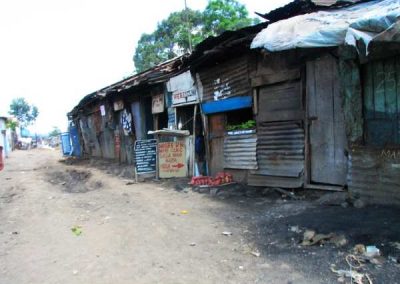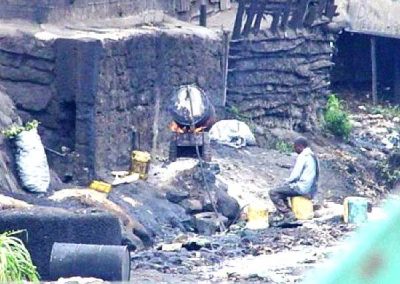Mathare Valley
Bridge Ministries is actively working in Nairobi, Kenya to rescue teenage children who are beyond the age limit for NGO sponsorship. No longer qualified to receive housing, food, and an education, we work with OneLife Africa to find these students and sponsor them for full scholarships. Though not all of our students are from the Mathare Slum, many of them are from similar areas of Nairobi. The lesson we learned from these teachers is one of personal sacrifice, as they often rallied around specific students to finance those students who exhibited extreme potential in their primary years. You can see from this video that despite extreme conditions, these children are excelling and many find themselves in the top 5,000 out of 700,000 eighth grade students in the nation. That’s where Bridge Ministries has the privilege of stepping into the gap, financing the scholarships, and answering the heartfelt prayers of these teacher-heroes.
Bridge Ministries is actively working in Nairobi, Kenya to rescue teenage children who are beyond the age limit for NGO sponsorship. No longer qualified to receive housing, food, and an education, we work with OneLife Africa to find these students and sponsor them for full scholarships. Though not all of our students are from the Mathare Slum, many of them are from similar areas of Nairobi. The lesson we learned from these teachers is one of personal sacrifice, as they often rallied around specific students to finance those students who exhibited extreme potential in their primary years. You can see from this video that despite extreme conditions, these children are excelling and many find themselves in the top 5,000 out of 700,000 eighth grade students in the nation. That’s where Bridge Ministries has the privilege of stepping into the gap, financing the scholarships, and answering the heartfelt prayers of these teacher-heroes.
In 2006, our international ministry began in Mathare Valley. Now, many years later, we have branched out to other areas in Nairobi, and beyond, but we still hold the people in Mathare very close to our hearts.
The Mathare Valley is one of the oldest and worst slum areas in Nairobi and the degree of poverty there is unimaginable. After being there, one can never forget Mathare, but visitors often find themselves lacking adequate words to describe it.
People live in 6 ft. x 8 ft. shanties made of old tin and mud. There are no beds, no electricity, and no running water. People sleep on pieces of cardboard on the dirt floors of the shanties. There are public toilets shared by up to 100 people and residents have to pay to use them.
Those who cannot afford to pay must use the alleys and ditches between the shanties. “Flying toilets” are plastic bags used by the residents at night, then thrown into the Nairobi River, which is the source of the residents’ water supply.
Approximately 600,000 people live in an area of three square miles. Most live on an income of less than a dollar per day. Crime and HIV/AIDs are common. Many parents die of AIDS and leave their children to fend for themselves. Local Christian ministries try to care for as many of these orphans as possible, but their resources are limited.
Industries in the slum include the corn-and-bean vendors, meat vendors, fish vendors, but perhaps most disturbing of all, the changa’a production, a deadly form of moonshine readily available in Mathare.
Mathare Facts:
-
- 70% of Nairobi’s population of four million lives on 5% of the of the city’s land area.
- Mathare Valley contains a population greater than the cities of Seattle, Denver, or Boston, yet the slum covers an area of only three square miles. In comparison, Seattle covers 80 square miles, Boston 42 square miles, and Denver 150 square miles.
- It is estimated that one of every three adults in Mathare is HIV positive.
- The average life expectancy for a person who is HIV positive in Mathare is five years or less. Upwards of 60% of the adult population is HIV positive in Mathare. The result are thousands of orphaned children.
- Common health problems for children in Mathare include dysentery, malnutrition, malaria, typhoid, cholera, infections, tetanus, and polio.
- Juvenile heads of households are common. This is a situation where a child or teen, some as young as 8 or 9 years old, is left to care for younger siblings, since both parents have died of AIDS.
- Mathare Valley has no police or fire protection, and no paved roads. The police in Nairobi are not allowed to enter the slum.
- There are an estimated 70,000 children in the Mathare Valley, with only 3 to 4 schools to educate. Many children do not attend school.
- Without an education and without being introduced to a life-changing relationship with Jesus Christ, children in the Mathare Valley face a future of crime, prostitution, drug abuse and disease.
Although Mathare is unique in that it does not have any emergency services, police presence, public water, or electricity, for a child living in any slum across Africa, life is desperate. Bridge Ministries is now reaching kids across cultural and tribal borders throughout Kenya. Knowing what Mathare Valley is like helps us all to understand the value of what we do. If one life can be helped, our efforts are not in vain. Now that we have been there ourselves,we can’t not help.

















